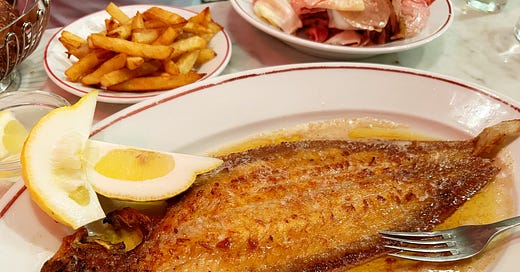Welcome to A Newsletter! Thank you for being here. If you’ve found your way over by some miracle but are not yet subscribed, let me help you with that:
Today for lunch I made a soup from three other soups. I had been eating soup one for six days until today, when I ate the last of it. The second soup was more of a single-ingredient soup, less a composed soup; it had been with me for three days (there is still some of that soup left). The third soup was definitely more a broth, and I’m not sure how long it had been with me because it was frozen and I only recently defrosted it, and I still never manage to label my containers. I probably have more of that same soup in the back of the freezer. Long live soup three!
If you asked me for a recipe for today’s soup, I wouldn’t be able to do that. I could tell you that it was brothy, that there were at least two types of meat in there and that it was spicy but not so spicy that I didn’t add more chili flake to the top. There were legumes in it (of course) and flecks of green things, coupled with vegetables that maybe shouldn’t ever be together in a pot. But the untangling and rewinding of three different soups to document one whole new soup would be an impossible task, the provenance of each one effectively a memory. Today’s soup is an ephemeral one, not made to be recreated, documented or tasted ever again.
SOUP ONE
The first soup was a pozole, something I love to make when I need something done ahead of time that easily feeds 6–8 people, something I can just set out bowls for and let people serve themselves and eat without any sort of babysitting or plating or timing concerns or whatever else I don’t want to do the night or day I decide to have people over.
This particular pozole was made with a very small amount of pork rib meat, since that was all I had in my freezer at the time and I wasn’t going to go to the store for a shoulder. It was for the best, because with a whole shoulder the pozole becomes more about the pork than the hominy, broth and toppings, which is my preference.
I started by searing the ribs in a giant pot, which didn’t give me as much fat as I had hoped, but that’s fine, I added some oil to compensate. I finely chopped two large yellow onions and sliced a head of garlic and added those to the fat to sweat out. I made a paste from a melange of dried chiles that I toasted, soaked and blended (a bulk of it fruity guajillo with a bit of spicy chili de arbol and smoky ancho), then added that to the tender onions and garlic, letting it sizzle and lightly caramelize in the fat. This chili paste for pozole is one of maybe seven things I’m willing to break out a food processor or blender for, since you really can’t get a smooth chili paste texture otherwise (I don’t have a good mortar and pestle, for some reason. I will try and buy one soon).
I added water to cover, seasoned aggressively with salt and simmered everything for a very long time, until the meat was falling off the bone. Halfway through I remembered I hadn’t added the hominy, which is fine since I couldn’t find dried so would be using canned (a good product that’s already cooked and is really just simmered long enough to absorb flavor). I opened the cans of hominy, drained and rinsed the kernels, added them to the pot and kept simmering on low for as long as I was awake for that day. The nice thing about it being cold outside is that you can store your soup on the porch overnight (if you have a heavy, tight fitting lid…animal prevention?), which is what I did.
The next day I brought the pozole back from its timeout on the porch and slowly reheated it. I kept it warm on the stove with a ladle inside the pot, the universal symbol for “please serve yourself, I will not be serving you.” I served it next to plates full of shredded green cabbage, carelessly chopped cilantro, thinly sliced yellow onion and radish, lime wedges that really weren’t all that juicy because they were old (my fault) and more dried chiles. There was also a plate of tostadas, which I find better for this than tortilla chips for sturdiness and DIY crumbling, as well as a little finely chopped Serrano chili mixed with raw garlic, salt and white distilled vinegar, for seasoning almost like hot sauce. I sure do love to celebrate any food that requires an abundance of toppings.
SOUP TWO
I’m using a lot of liberties here calling this a soup– it’s definitely more a pot of chickpeas swimming in a broth, but a broth good enough to call a soup. Earlier this summer an older gentleman in Greece cooking in a wood oven taught me how to make these chickpeas after, through an attempt at translation on both ends, I told him I also have a wood oven and am looking for more things to cook inside of it.
In Sifnos they call this specific version of long cooked chickpeas Revithada. Dried chickpeas covered with water, seasoned with salt, topped with a good amount of olive oil and thinly sliced onions or shallots—There can be other things added to the pot, depending on who’s making them (fresh bay or dried oregano are popular, and since I just bought a tiny bay leaf tree at a plant sale, I added a tiny fresh bay leaf*), but regardless, they are simply covered with a tight fitting lid and baked in an oven for a very long time until the chickpeas are completely tender and the onions take on a jammy, roasted texture that float to the top, lightly browning in that thick layer of olive oil. “A Long Time,” is of course not an actual unit of measurement, but depending on the oven and how hot it is or isn’t, it can be 4 hours, 7 hours, 10 hours, 14 hours. Whether or not these chickpeas can count as a soup will pretty much only depend on how much water you add and end up with. Semantics, really.
I cooked mine overnight in a cooling wood oven, and I have no idea what temperature it was at any given time, but I know that the oven was hot when they went in, and not very hot when I took them out ten hours later. They were the most tender, creamy chickpeas I have ever made.
*Bay leaves are a divisive ingredient that tend to elicit some pretty uninteresting opinions from people who don’t cook that often. I find the flavor to be subtle but decidedly present, “herbaceous” (a cop out of an adjective), slightly eucalyptus-y with a bit of festive pepperiness. I also love the way they look floating in liquid and olive oil, or tucked around wedges of onion when braising a large piece of meat. TLDR; Yes, I do love the flavor they bring, but if “they look so nice” is the only reason for me adding bay leaves, then so be it, let me live.
My preference is fresh, which can be hard to find unless you live in California or other places with lots of fresh bay at your disposal, but dried also is nice (my only endorsement of a dried herb). As with most things involving cooking, I say do it, or don’t. Soak your beans, or don’t. Peel your onions or don’t. Use the bay leaf, or don’t. I rarely make a habit of asking anyone to do something I don’t find totally necessary or worth it, so I hope at this point, at least one person reading this is figuring out where to buy a small bay leaf tree to keep in their apartment (a live plant is always worth it, whether the leaves end up in your soup or not).
SOUP THREE
Soup three was just frozen chicken broth I had made, probably from the carcass of a roasted chicken. I do this every time I roast a chicken, not dissimilar to ham bone broth, and thus my freezer is never without at least one or two quarts of homemade chicken broth. To do this, take the carcass of your last roasted bird and place it in a medium pot with a chopped onion, skin and all, some vegetables (including but not limited to: celery, carrots, parsnip, fennel, turnip), a good amount of salt, and whatever was inside the cavity of that bird. Simmer this on medium until you need to go to bed, then strain it into whatever reusable glass or plastic containers you prefer, then freeze and forget about it until one day you wake up and absolutely need some nice homemade broth. You can also make it intentionally from uncooked chicken (matzo balls optional, of course).
SOUP FOUR
So soup four, that Ephemeral Soup. Imagine blending the pork and hominy studded chili broth with some long cooked chickpeas and thinned out with some defrosted long-ago made chicken broth. Already delicious, but in the name of trying to be more mindful of the produce I throw away, I added the last of the shredded cabbage, torn bodega kale and a half a stalk of limp celery (thinly sliced) to soften in the soup before cracking an egg to swirl around and cook in the broth. I finished it with more olive oil, crushed red pepper flakes and the sad juice of a little old lemon nub.
It wasn’t an especially gorgeous soup, but it was very delicious, with an almost tomato-less minestrone energy, which was nice, because that’s a soup I’ll never make on purpose. That got me thinking about canned tomatoes and how much I enjoy them in soups, especially in the wintertime, when there are no nice, fresh tomatoes. Then, of course, all I could think about was how I wish I liked tomato soup more, which is really just to say, I wish it wasn’t so smooth and pureed, reminding me of food for babies.
SOUP FIVE
This very “If You Give A Mouse A Cookie” logic leads us to soup five. Wholly unrelated to the first four, this soup contains only the raw ingredients for which to create a whole new, documentable, recreate-able soup, which will hit the inbox tomorrow morning for all paid subscribers. It’s tomato soup with texture, it’s pantry-staple based because of course it is, it’s spicy, tangy, it’s perfect as its accidentally vegan self with the option to add sour cream. It’s light, it’s filling, it inexplicably makes you feel SO ALIVE? I’ve made it twice already since December, and well, I’m in love.
Happy New Year and thank you so much for reading. See you tomorrow.
























I love this. I love them all but casting my vote for more essay-like installments of a newsletter
I know this is not on brand for you, but I just bought an electric pressure canner so I can store my soups on the shelf FOREVER.